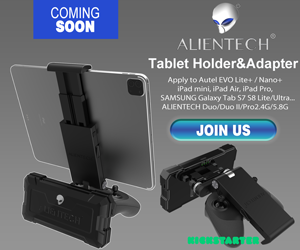You are using an out of date browser. It may not display this or other websites correctly.
You should upgrade or use an alternative browser.
You should upgrade or use an alternative browser.
Overlaying a housing lot file into your drone video
- Thread starter jmason702
- Start date
Never did that, also I don't know much about video editing.
But I would try this:
1) Get a large housing lot image on your PC.
2) Import video (top-down view) and lot image into the post-processing software (e. g. DaVinci Resolve).
3) Set a tracker at a distinct spot of the video.
4) Map the lot image to the tracker.
5) Use Transform feature for aligning and sizing the lot image, also for selecting blend mode and transparency.
your idea sounds good, but the lot plan file is for sure a PDF or KML file of some sort, that would need to be uploaded into the editing software.Never did that, also I don't know much about video editing.
But I would try this:
1) Get a large housing lot image on your PC.
2) Import video (top-down view) and lot image into the post-processing software (e. g. DaVinci Resolve).
3) Set a tracker at a distinct spot of the video.
4) Map the lot image to the tracker.
5) Use Transform feature for aligning and sizing the lot image, also for selecting blend mode and transparency.
waltermitty
Well-Known Member
I'm only in the studying and reading stages but in my head, as depicted in the OP's first post, I see this as a morphing of the numbers being incorporated photos which would be fed into the 3D mapping library. If you're not needing to have 3D type, rotational rendering as a feature, you can simply include a static photo and have the video pause to show the house number overlay photo.
herein2021
Well-Known Member
@Landey was pretty close, below is how I would do it in Davinci Resolve:
- Get the lot plan and convert it to PNG, no other image format would work properly. You will need to convert it to a PNG with transparency. I would convert it in something like Paint.Net but getting high quality results would take a long time, ideally, they would submit it to you as a PNG already.
- Film the site with the drone but pay special attention to the clips where you plan to overlay the lot plan. For those clips keep the drone very slow and steady, no fancy movements.
- Edit the video like normal (titles, callouts, audio track, etc).
- Go back and for the clips that will have the overlay create a new Fusion composition by right click > Open in Fusion
- This will place the video clip to a background node and link it to the Output
- Create a new merge Node and link it between the output from the background to the output for the video
- Make sure the video clip is linked to the background input of the merge node then add a new Transform node do the foreground of the merge node
- Create a new tracker and track forward and backwards through the video clip
- Take the results of the tracker and feed them into the transform node
- Add the overlay to the input for the transform node and properly scale the overlay to the footage in the clip
- Play the whole thing forward and backwards to test it out.
If you are not familiar with nodes in Fusion then this will be nearly impossible to complete without many hours of studying and practicing in Fusion using online tutorials. Also, the integrated Fusion performs very poorly performance wise so be prepared for a lot of frustration as it renders.
BTW if you want to know exactly how they did it in the sample video all they did was use overlays in the Google Earth Desktop app, they placed the drone in very stationary points at certain locations onsite, then added the overlay to the video footage and did a crossfade transition from Google Earth to the video footage. All of the fancier motion was done in Google Earth which made the job much simpler than trying to corner pin, 3D track, etc.
The whole project probably started as a KML file and they used a KML to PNG converter to import the file into their video editor.
Last edited:
Thank you so much for your time explaining this! the file type is important info.@Landey was pretty close, below is how I would do it in Davinci Resolve:
You will now have the overlay properly tracked to the background drone clip. I have overly simplified a few of the steps you will probably need to also do some corner pinning and possibly will need to use a 3D tracker if you want Z axis movement, but those are the basics.
- Get the lot plan and convert it to PNG, no other image format would work properly. You will need to convert it to a PNG with transparency. I would convert it in something like Paint.Net but getting high quality results would take a long time, ideally, they would submit it to you as a PNG already.
- Film the site with the drone but pay special attention to the clips where you plan to overlay the lot plan. For those clips keep the drone very slow and steady, no fancy movements.
- Edit the video like normal (titles, callouts, audio track, etc).
- Go back and for the clips that will have the overlay create a new Fusion composition by right click > Open in Fusion
- This will place the video clip to a background node and link it to the Output
- Create a new merge Node and link it between the output from the background to the output for the video
- Make sure the video clip is linked to the background input of the merge node then add a new Transform node do the foreground of the merge node
- Create a new tracker and track forward and backwards through the video clip
- Take the results of the tracker and feed them into the transform node
- Add the overlay to the input for the transform node and properly scale the overlay to the footage in the clip
- Play the whole thing forward and backwards to test it out.
If you are not familiar with nodes in Fusion then this will be nearly impossible to complete without many hours of studying and practicing in Fusion using online tutorials. Also, the integrated Fusion performs very poorly performance wise so be prepared for a lot of frustration as it renders.
BTW if you want to know exactly how they did it in the sample video all they did was use overlays in the Google Earth Desktop app, they placed the drone in very stationary points at certain locations onsite, then added the overlay to the video footage and did a crossfade transition from Google Earth to the video footage. All of the fancier motion was done in Google Earth which made the job much simpler than trying to corner pin, 3D track, etc.
The whole project probably started as a KML file and they used a KML to PNG converter to import the file into their video editor.
That is 'Screencast-O-Matic'or just import the video file into Screecast-O-Matic, draw the lot lines in using the polygon shape in the edit mode and then re-export the edited video. You take a slight hit on resolution but save a lot of work!
herein2021
Well-Known Member
or just import the video file into Screecast-O-Matic, draw the lot lines in using the polygon shape in the edit mode and then re-export the edited video. You take a slight hit on resolution but save a lot of work!
I don't understand how screen recording software would possibly come close to matching the reference video that the OP linked in the first post. When working projects like those the client hands you a site plan, it is exactly to scale and very detailed, how would screen recording software produce the reference video as the final product? Drawing lot lines by hand would not be to scale, would not have sufficient detail, and would not result in a commercially viable product for a construction or marketing client. Davinci Resolve has the same tool but there's no way I would recommend trying to reproduce a site plan with it. Site plans come from the builder's architect, they are very precise and drawn to scale, there's no way to reproduce those with a polygon tool in an NLE. You could do something like that for a real estate agent who simply wants to show the lot lines around a perimeter, but definitely not for a commercial client with a site plan. For simple lot lines it would take only a few seconds in DR to draw those, corner pin them, then turn them into 3D lines.
I definitely agree that nothing about this project is easy or quick, but if the customer is willing to pay you for your time then the only thing that matters is that the client is happy with the final product. The important thing though is to quote the client an accurate services proposal with the amount of time it will take you to produce what they expect otherwise you will end up spending many unpaid hours trying to get it done.
Last edited:
I suggested to the client to map the area then overlay the file as geo-referenced shapefile into the map, then make a video of the map and overlay with screen recording...
They said they would get back to me
They said they would get back to me
gschulzuio
Well-Known Member
- Joined
- Dec 14, 2020
- Messages
- 727
- Reaction score
- 373
Looks like they are using one of the CG/3D/VR/Cupix rendering services and or tools based on how they have added animated moving vehicles, other generated content. Some of the images are GE based, however others are not and you can see where the CG gets added in (e.g. moving vehicles, how they move, where they move, color/contrast of roads etc. You could do something with DR and Fusion, as well as with other video editing tools using tracking, however could get tricky and time consuming depending on how much and what they want to do. Some of the CG/3D/VR software can take aerial/drone footage and pull it in to augment views and help with the output. Have done some projects where get request to go to x,y location, go up to z altitude, then capture images (still, video, 360 spherical) that then gets loaded into app that produces something long lines of what shown. As you point out below, you could also do a map mission, then do an overlay, then record the resulting screen image (e.g. similar to recording screen view of when you do a 3D model and want to share).
Similar threads
- Replies
- 11
- Views
- 716
- Replies
- 0
- Views
- 291
- Replies
- 3
- Views
- 282
- Replies
- 0
- Views
- 617
- Replies
- 3
- Views
- 670
Latest threads
-
-
Onocoy NTRIP. Has anyone tried this set up for RTK drone survey (photo mosaic and 3D capture and generation).
- Started by HorusQcopter
- Replies: 0
-
-
-




